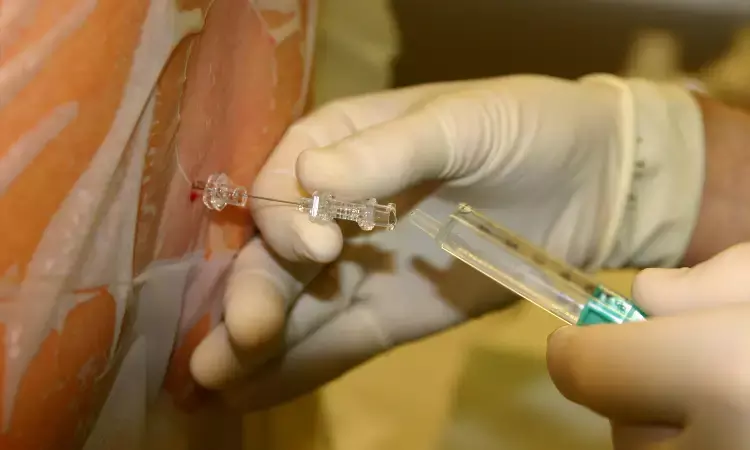- Home
- Medical news & Guidelines
- Anesthesiology
- Cardiology and CTVS
- Critical Care
- Dentistry
- Dermatology
- Diabetes and Endocrinology
- ENT
- Gastroenterology
- Medicine
- Nephrology
- Neurology
- Obstretics-Gynaecology
- Oncology
- Ophthalmology
- Orthopaedics
- Pediatrics-Neonatology
- Psychiatry
- Pulmonology
- Radiology
- Surgery
- Urology
- Laboratory Medicine
- Diet
- Nursing
- Paramedical
- Physiotherapy
- Health news
- Fact Check
- Bone Health Fact Check
- Brain Health Fact Check
- Cancer Related Fact Check
- Child Care Fact Check
- Dental and oral health fact check
- Diabetes and metabolic health fact check
- Diet and Nutrition Fact Check
- Eye and ENT Care Fact Check
- Fitness fact check
- Gut health fact check
- Heart health fact check
- Kidney health fact check
- Medical education fact check
- Men's health fact check
- Respiratory fact check
- Skin and hair care fact check
- Vaccine and Immunization fact check
- Women's health fact check
- AYUSH
- State News
- Andaman and Nicobar Islands
- Andhra Pradesh
- Arunachal Pradesh
- Assam
- Bihar
- Chandigarh
- Chattisgarh
- Dadra and Nagar Haveli
- Daman and Diu
- Delhi
- Goa
- Gujarat
- Haryana
- Himachal Pradesh
- Jammu & Kashmir
- Jharkhand
- Karnataka
- Kerala
- Ladakh
- Lakshadweep
- Madhya Pradesh
- Maharashtra
- Manipur
- Meghalaya
- Mizoram
- Nagaland
- Odisha
- Puducherry
- Punjab
- Rajasthan
- Sikkim
- Tamil Nadu
- Telangana
- Tripura
- Uttar Pradesh
- Uttrakhand
- West Bengal
- Medical Education
- Industry
Prevalence of shivering lower with intrathecal bupivacaine with fentanyl compared to bupivacaine alone in patients undergoing cesarean

The human body has a core temperature that typically falls between the range of 36.5°C to 37.5°C. The core temperature is regulated by the autonomic nervous system via the implementation of behavioral and physiological modifications. The administration of spinal anesthetic has been shown to have negative effects on vasoconstriction below the blocked segments, as well as on the transfer of body heat from the central to peripheral regions. This might result in intraoperative core hypothermia. The present research aimed to evaluate the effectiveness of incorporating a low dosage of fentanyl intrathecally (12.5 μg) in mitigating the incidence of intraoperative shivering and hypothermia, while also documenting any noteworthy adverse effects within this specific group of patients.
The present study included a sample of 148 individuals who had cesarean section while under spinal anesthesia, using a randomized controlled trial design. A total of 148 patients were included in the study, with 74 patients receiving spinal anesthetic using 1.8 mL of hyperbaric bupivacaine (0.5%), while the other 74 patients were provided 12.5 μg of intrathecal fentanyl along with 1.8 mL of hyperbaric bupivacaine. A comparison was conducted between the two groups to determine the occurrence of shivering, as well as the changes in nasopharyngeal and peripheral temperature. Additionally, the temperature at the commencement of shivering and the severity of shivering were also assessed.
The prevalence of shivering was found to be 9.46% in the group receiving intrathecal bupivacaine with fentanyl, which was considerably lower compared to the group receiving intrathecal bupivacaine alone (41.89%). Both groups had a declining trend in nasopharyngeal and peripheral temperature, with the simple bupivacaine group demonstrating higher values.
The present investigation demonstrates that the administration of 12.5 mcg of intrathecal fentanyl as an adjuvant in the subarachnoid block effectively mitigates shivering without eliciting any adverse effects, including pruritus, nausea, vomiting, unfavorable newborn outcomes, or respiratory depression. The observed decrease in shivering, despite similar core temperatures in both groups, may be related to the administration of fentanyl. Fentanyl has been shown to lower the temperature threshold for shivering via its impact on the central nervous system.
Reference –
Thakur, Niraj; Balachander, Hemavathi; Rudingwa, Priya; Panneerselvam, Sakthirajan. Shivering and changes in body temperature in patients undergoing caesarean section under spinal anaesthesia with bupivacaine vs bupivacaine and fentanyl: A randomized clinical study. Journal of Anaesthesiology Clinical Pharmacology 39(1):p 67-73, Jan–Mar 2023. | DOI: 10.4103/joacp.joacp_156_21
MBBS, MD (Anaesthesiology), FNB (Cardiac Anaesthesiology)
Dr Monish Raut is a practicing Cardiac Anesthesiologist. He completed his MBBS at Government Medical College, Nagpur, and pursued his MD in Anesthesiology at BJ Medical College, Pune. Further specializing in Cardiac Anesthesiology, Dr Raut earned his FNB in Cardiac Anesthesiology from Sir Ganga Ram Hospital, Delhi.
Dr Kamal Kant Kohli-MBBS, DTCD- a chest specialist with more than 30 years of practice and a flair for writing clinical articles, Dr Kamal Kant Kohli joined Medical Dialogues as a Chief Editor of Medical News. Besides writing articles, as an editor, he proofreads and verifies all the medical content published on Medical Dialogues including those coming from journals, studies,medical conferences,guidelines etc. Email: drkohli@medicaldialogues.in. Contact no. 011-43720751


